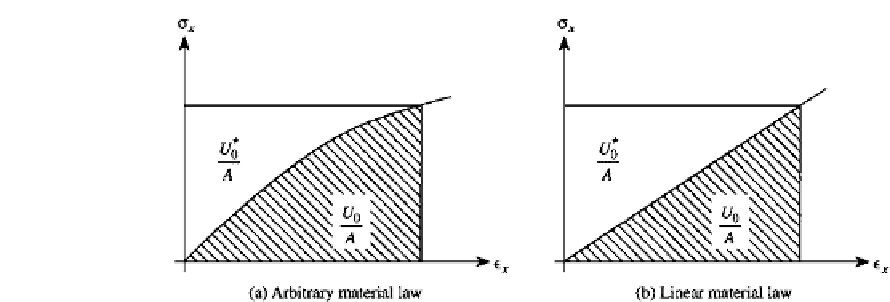Information Technology Reference
In-Depth Information
FIGURE 2.2
Strain energy and complementary strain energy densities for an axially stressed bar.
where
U
0
is called the
complementary strain energy density.
For the linear material law of
Fig. 2.2b,
U
0
U
0
.
For the general solid, this gives a useful alternative representation for the strain energy;
the complementary strain energy density
U
0
(σ )
U
0
, whereas for the nonlinear material law of Fig. 2.2a,
U
0
=
=
is
U
0
(σ )
=
σ
ij
ij
−
U
0
()
(2.14)
This relationship, which is sometimes referred to as Friedrichs'
1
transformation, implies
that if the strain energy density exists, then the existence of the complementary strain energy
density is assured. In the case of a linear material law [Chapter 1, Eqs. (1.32)],
=
E
−
1
σ
or
F
ijkl
σ
kl
,U
0
(σ )
ij
=
can be expressed as a function of the stress components alone.
1
2
σ
T
1
2
σ
T
E
−
1
σ
U
0
(σ )
=
σ
T
−
=
2
E
(σ
+
ν)
σ
33
(2.15)
1
2
2
12
2
13
2
23
=
+
σ
+
σ
)
+
2
(
1
+
σ
+
σ
−
σ
σ
−
σ
σ
−
σ
σ
11
22
33
11
22
11
33
22
With a linear material law, there is no difference between
U
0
, a function of strain compo-
nents, and
U
0
, a function of stress components. This contention follows from
1
2
T
E
1
2
T
σ
1
2
σ
T
1
2
σ
T
E
−
1
σ
U
0
=
=
=
=
=
U
0
In general, for most plastic materials,
U
0
is not equal to
U
0
.
The complementary strain energy, that is, the complementary potential of the internal
forces,
U
i
, for the whole body can be written as
1
2
1
2
U
i
=
U
0
(σ )
σ
T
E
−
1
σ
dV
dV
=
F
ijkl
σ
ij
σ
kl
dV
=
(2.16)
V
V
V
1
Kurt Otto Friedrichs was born in 1901 in Kiel, Germany. He worked with Richard Courant, John von Neumann,
Hans Lewy, and J.J. Stoker and is credited with many developments in mathematics and mechanics. He received
his doctoral degree from the University of G ottingen in 1925. He was at G ottingen in 1925-27, Aachen in 1927-29,
and Braunschweig in 1930-37. He departed Germany, along with other scientists in the late 30s. In 1937 he joined
the faculty of New York University, where he eventually became the director of the Courant Institute.










Search WWH ::

Custom Search